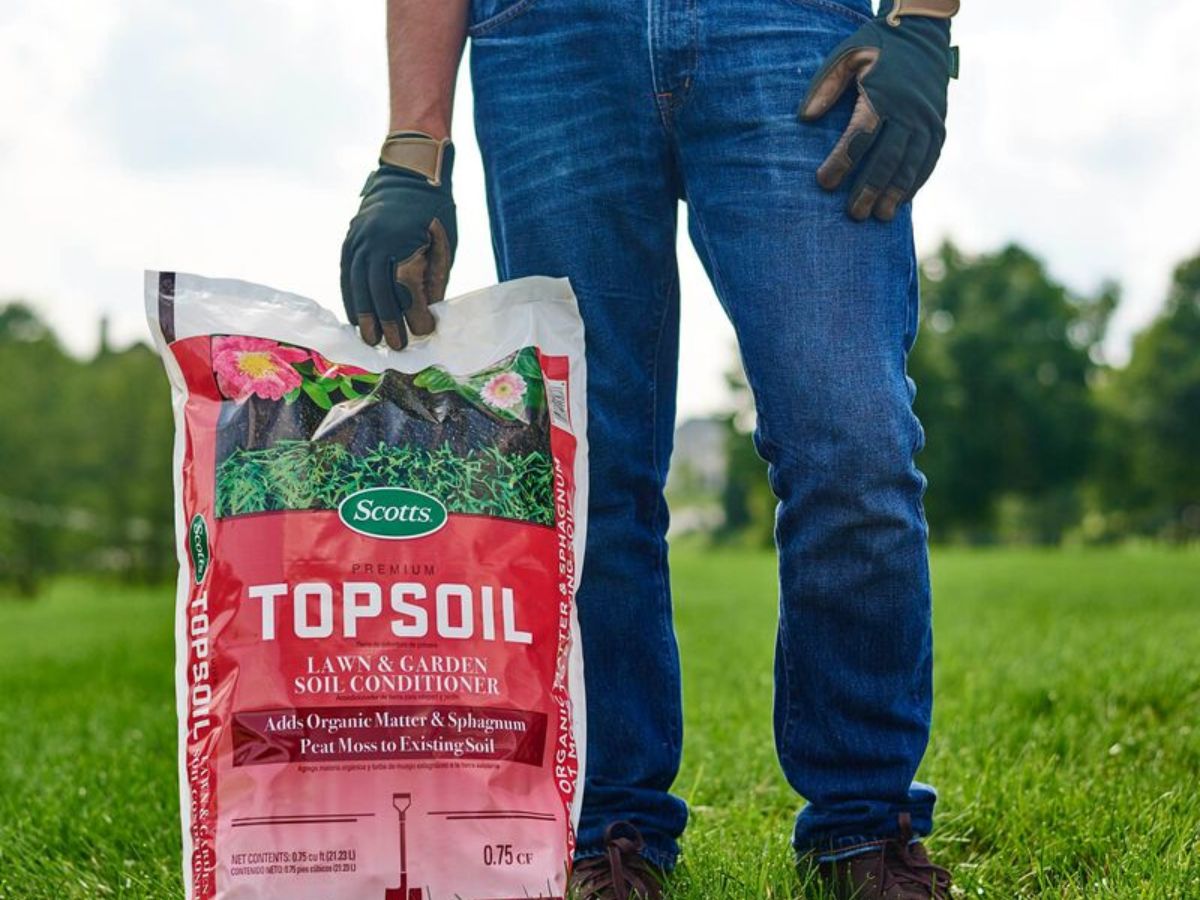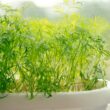In This Article Show
Imagine you’re standing in a garden center aisle, looking at a sea of bags labeled ‘Topsoil’ and ‘Scotts Lawn Soil’. If you’re anything like most gardeners, you may ask yourself, “Which one is better for my garden?” Don’t worry; you’re not alone.
As a lawn care expert with over 13 years of experience, I’ve been in your shoes, and I’m here to help you make the best decision for your garden.
Soil forms the foundation of our gardens. It feeds our plants, supports their roots, and retains the precious water they need to survive. Picking the right soil type can be the difference between a thriving, vibrant garden and one that struggles to support life.
In this post, we’ll talk about soils. Specifically, we’re looking at two of the most popular options on the market: topsoil and Scotts Lawn Soil. Both types have merits and drawbacks, but understanding their differences can help you pick the best one for your needs.
Understanding Soil Composition
As a seasoned lawn care expert, I’ve spent years getting my hands dirty with all sorts of soil. It’s a fascinating world; understanding soil composition is fundamental to successful gardening. So before we delve into the specifics of topsoil and Scotts Lawn Soil, let’s brush up on the basics of what makes up soil.
1. Soil is Not Just ‘Dirt’
It’s a complex mixture of decomposed organic matter, minerals, water, and air. These elements work together to create the perfect environment for plants to grow.
Get Gardening For Beginners
Our new EBOOK shows newcomers and green thumbs alike a step by step guide to growing the garden of their dreams.
2. Organic Matter
Organic matter is derived from decomposed plants and animals. It’s rich in nutrients that plants need to grow and thrive. This component aids in the retention of moisture and enhances the soil’s ability to hold onto essential nutrients.
3. Minerals
These are derived from weathered rocks and include sand, silt, and clay components. Minerals provide structure to the soil and play a significant role in its drainage properties and nutrient-holding capacity.
4. Water
Water is critical for plant growth. The soil’s water-holding capacity determines how much water is available for plants after precipitation or irrigation.
5. Air
Believe it or not, air is a crucial component of soil. Soil needs to be loose and porous for roots to breathe and grow.
Now that we have a basic understanding of what soil is and its importance in gardening, let’s delve deeper into the specifics of topsoil and Scotts Lawn Soil.
The Basics of Topsoil
Topsoil, as its name suggests, is the uppermost layer of soil. It’s typically the first 5 to 12 inches of soil, where most of the soil’s biological activity occurs. This layer is rich in organic matter and microorganisms, both of which are beneficial for plant growth.

Advantages of Topsoil
Topsoil is often used to fill gardens, improve the existing soil in a garden, or as a base for new lawns. It’s a popular choice because of its nutrient-rich composition and versatility. Here are some of the advantages of topsoil.
Get Gardening For Beginners
Our new EBOOK shows newcomers and green thumbs alike a step by step guide to growing the garden of their dreams.
1. Rich in Nutrients
Topsoil is rich in nutrients due to the high concentration of organic matter. This makes it an excellent choice for promoting healthy plant growth.
2. Versatility
Topsoil can be used for a wide variety of gardening tasks. Whether you’re creating a new garden bed, laying a new lawn, or improving your garden’s soil, topsoil can get the job done.
3. Affordability
Generally, topsoil is relatively inexpensive compared to specialized soil products, making it a cost-effective option for large-scale projects.
Disadvantages of Topsoil
1. Inconsistent Quality
The quality of topsoil can vary greatly depending on its source. Some may be nutrient-rich, while others might be depleted or contain weed seeds or pests.
2. Poor Drainage
Topsoil often has a high clay content, leading to poor drainage. This can be problematic for plants that require well-drained soil.
The Essentials of Scotts Lawn Soil
Scotts Lawn Soil is a specialized product designed for the needs of lawns. It’s not just soil; it’s a blend of soil, compost, and other organic materials formulated to create an optimal environment for lawn grasses to grow and thrive.
Advantages of Scotts Lawn Soil
Here are some of the advantages of Scotts Lawn Soil.

1. Nutrient-Enriched
Scotts Lawn Soil is packed with added nutrients that are specifically chosen to benefit lawn grasses. This gives your grass a healthy start and keeps it nourished over time.
2. Good Water Retention
The composition of Scotts Lawn Soil promotes water retention while still allowing for good drainage. This balance keeps your lawn hydrated without causing soggy conditions that can harm your grass.
3. Weed Control
Some versions of Scotts Lawn Soil have added weed control, helping you maintain a neat, tidy lawn without the extra hassle of weeding.
Disadvantages of Scotts Lawn Soil
1. Cost
Scotts Lawn Soil tends to be more expensive than regular topsoil due to the added nutrients and other features. This may make it less suitable for gardeners on a tight budget or those with large areas to cover.
2. Specialization
While Scotts Lawn Soil is excellent for lawns, it may not be the best choice for other types of plants. The nutrients and composition are designed explicitly for grass, and while it won’t harm other plants, they may not benefit as much from this specific mix.
3. Availability
Depending on where you live, Scotts Lawn Soil may not be as readily available as generic topsoil. This could mean planning your gardening projects in advance or seeking alternative sources.
Now that we have a solid understanding of both topsoil and Scotts Lawn Soil, let’s compare them side by side.
Next, we’ll weigh the pros and cons, discuss cost-effectiveness, and look at the versatility of each option. This comprehensive comparison will provide a clearer picture of which soil best fits your gardening needs.
Scotts Lawn Soil vs Topsoil – A Comparative Analysis
As a seasoned lawn care expert, I have used both topsoil and Scotts Lawn Soil in various settings over the years. Both options have their unique advantages, but the best choice depends on your specific needs and goals. Here, we’ll compare them to several key factors.
1. Nutrient Content
Topsoil is naturally rich in nutrients due to its high organic matter content. However, the nutrient content can vary based on its source. On the other hand, Scotts Lawn Soil comes enriched with specific nutrients for lawn health, providing consistent and targeted nourishment for your grass.
2. Water Retention Capability
Topsoil often contains a high percentage of clay, which retains water well but may lead to poor drainage if it’s too high. Scotts Lawn Soil strikes a balance between water retention and drainage, making it beneficial for lawns.
3. Ease of Use and Versatility
Topsoil is incredibly versatile, used in everything from filling garden beds to laying new lawns. In contrast, Scotts Lawn Soil is formulated specifically for lawns. While it can be used elsewhere, it won’t necessarily offer the same benefits for other plants as it does for grass.
4. Price
Topsoil is generally cheaper and more readily available than Scotts Lawn Soil. However, if you’re willing to invest in the health of your lawn and seek targeted benefits, the additional cost of Scotts Lawn Soil could be justified.
After comparing these factors, it’s clear that neither type of soil is universally ‘better’ than the other. Each has its place, and the right choice depends on the specifics of your project.
Which Soil Should You Choose?
| Criteria | Scotts Lawn Soil | Topsoil |
|---|---|---|
| Purpose | Specifically designed for lawns | General-purpose soil for a variety of gardening tasks |
| Nutrient Content | Enriched with specific nutrients beneficial for lawns | Rich in nutrients due to high organic matter, but quality can vary |
| Water Retention | Balanced water retention and drainage | High water retention, may have poor drainage depending on clay content |
| Versatility | Primarily for lawns, may not offer the same benefits for other plants | Versatile, can be used for a wide range of gardening tasks |
| Cost | More expensive due to added nutrients and lawn-specific formulation | Generally cheaper, making it suitable for large-scale projects |
| Availability | May not be readily available in all regions | Generally available in most regions |
Drawing from my 13 years of experience in lawn care and gardening, I’ve come to learn that choosing the right soil is dependent on your specific needs, the type of plants you’re growing, and the condition of your existing soil. With this in mind, let’s look at the best scenarios for each soil type.
When to Choose Scotts Lawn Soil:
- Starting a New Lawn or Overseeding: If you’re starting a new lawn or overseeding an existing one, Scotts Lawn Soil is a great choice. It’s specifically formulated to encourage strong root development and growth in grasses.
- Lawn Repair: If parts of your lawn are bare or struggling, using Scotts Lawn Soil can give your grass the nutrient boost it needs to recover and flourish.
- If You Want Targeted Nutrient Content: Scotts Lawn Soil comes enriched with specific nutrients for lawns. If your goal is targeted nourishment for your grass, this is your go-to soil.
When to Choose Topsoil:
- General Gardening: If you’re filling garden beds, establishing a new vegetable garden, or improving the quality of existing soil, topsoil is a versatile and cost-effective choice.
- Large-Scale Projects: For projects that require a large volume of soil, such as creating new beds or leveling your garden, topsoil is often the more economical choice.
- When You Need Soil Fast: Topsoil is generally more readily available than specialty soils. If you need soil quickly and don’t have specific nutrient requirements, topsoil is a practical choice.
In conclusion, whether Scotts Lawn Soil or topsoil is the better choice for you largely depends on your specific gardening project and needs. Both have their unique strengths, and understanding these can help you make the best choice for your green spaces.
Wrapping it up
Choosing between Scotts Lawn Soil and topsoil isn’t about finding the ‘best’ soil, but about finding the ‘right’ soil for your gardening needs.
With its targeted nutrients, Scotts Lawn Soil is ideal for lawn-specific needs, while the versatility and affordability of topsoil make it suitable for a broad range of gardening tasks.










